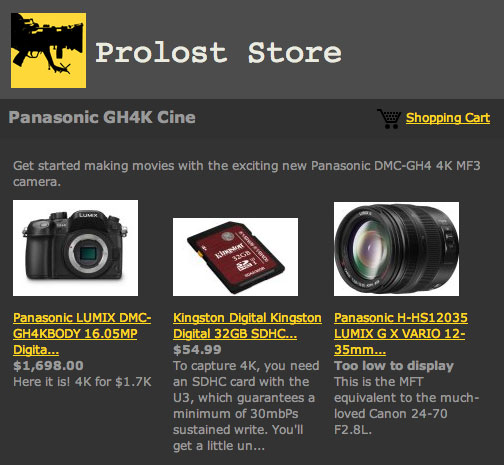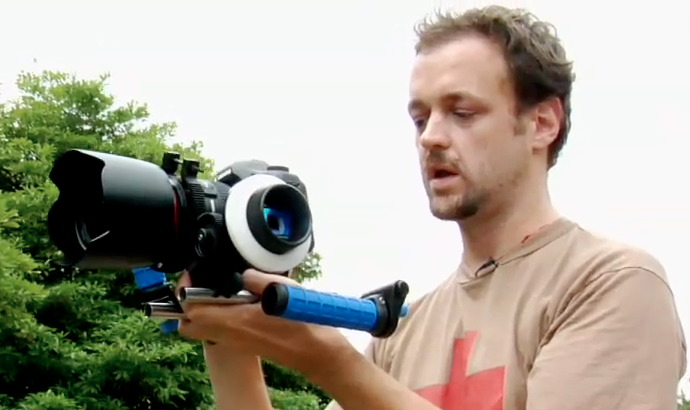Production Audio is Ripe for Revolution
 Monday, September 10, 2012 at 10:11AM
Monday, September 10, 2012 at 10:11AM Dear companies that make production audio gear,
I love filmmaking. I love shooting. I love everything about the on-set experience.
Except recording audio.
When I’m filmmaking like a grown-up, I have someone else—an expert—handle dialogue recording. But often, it’s just me. Me and my portable audio recorder and expensive microphones and absolutely no frigging idea what I’m doing.
I’m a pretty smart guy. I truly get, in my bones, that poor production audio is the quickest way to sink an indie production. So I’m motivated to learn more about audio. I’ve tried, and tried. But it doesn’t stick.
My shotgun microphone has a little switch on it. That switch has two positions. One is the right one, one is the wrong one. You know what? It would be easier to just re-write this short to have no dialogue.
You’re probably thinking that I’m a lazy idiot. You might be right, but I think there are others like me too. Production audio is one of those fields populated by experts who have long forgotten what it was like to ever not have a complete grasp of hypercardioid patterns, phantom power, and 60Hz hum. To those experts, we who scratch our heads at those terms must seem so thickheaded. But trust me guys, this stuff you know forward and back is actually quite maddeningly opaque from the outside.
Audio is hard. And everyone who understands it seems to have forgotten that. So they suck at explaining it. And so here I sit, recording bad dialogue with many hundreds of dollars in gear, feeling like an idiot.
Or a tremendously underserved market.
The Revolution of Easy
Video is hard too. But people are working like crazy to revolutionize it so that people unable, unwilling, or just plain uninterested in becoming video or photo experts can still make great-looking images. 1080p cameras fit in the palm of your hand—and then employ elaborate stabilization methods to fix the jitter caused by their own weightlessness. Your iPhone merges multiple exposures into a single HDR the moment you press the virtual shutter button. And I, for my part, work hard daily to design color correction tools that make sense to anyone who has ever seen a lens or a ray of light. When I’m at my best, I can make anyone feel like a color correction expert. But I know I can do better. We’re all working really hard on the problem of helping you make the images you want.
Is this happening in audio as well? If it is, I don’t see it. I see evolution, not revolution. I see better tools for experts, not tools designed to make us idiots feel like experts.
Being a video nerd, I know that the imagery from that pocket HD camcorder isn’t stellar, and that the HDR capture from an iPhone isn’t as good as an exposure merge from a DSLR. But I also recognize that these consumer toys are helping people capture much, much better images than the enthusiastic amateur has ever been able to.
There’s a huge, untapped opportunity to do the same for audio.
Abuser Interface
Have you ever navigated the menu of a Zoom H4N? It’s like playing a Chinese knockoff of Tetris on a Gameboy that was run over by a car.
Like every filmmaker I’ve ever met, I own an iPhone. Build your portable audio recorder around that. Make a great app to control it. Sell a kit with a badass shotgun mic in a shockproof mount, one of those furry sock things, and a connector that connects to my iPhone (which you already know how to do).
But don’t just use the iPhone as a better screen for your crappy User Interface. Don’t even think it’s enough to use it as a platform for new, sexier UI. Put that little pocket supercomputer to work to make my life as a filmmaker easier.
Rate the quality of my incoming audio on the screen, live. Warn me when I have a bad echo, or background noise. Suggest fixes. I’ll move the mic around as instructed and watch the quality level change, and then stop moving when it’s great.
Listen for me saying the word “check” and set the audio levels automatically when you recognize that word. Flash an alert on the screen if you detect a hum. Or an airplane flying overhead.
Some Sony cameras have a mode that automatically snaps a photo when the subject smiles. Step up the tech, audio nerds. I know you can do this stuff.
The Wire
A good wireless lavalier kit goes for roughly four times the cost of an iPod touch, and suffers from radio interference and complexity. Build me a lapel mic that wires to an iPhone/iPod in my actor’s pocket and you just saved me endless headaches and hundreds of dollars.
Heck, I’ve never met an actor who didn’t have an iPhone. I’ll install the app on their phone and save a few more bucks. That way I can actually keep their data connection on, and your app can send recording levels and other reports to my phone, so I can monitor and control multiple mics on one touchscreen. Start and stop them all simultaneously with the push of a button (like GoPro already does with their pocket HD cameras). And let my intern log into the same account and tag the incoming audio files with slate info and other useful metadata, like the name of the character being recorded—all while we work.
Know that I have PluralEyes
Post isn’t easy, but it’s much more forgiving than production. You have time to correct your mistakes, and you have some truly magical tools at your disposal, such as PluralEyes. Recently acquired by my friends at Red Giant, this technology aligns sound and picture tracks based on audio waveforms. Which means that you can automatically sync your high-quality production audio with your video and its crummy scratch track from the camera mic.
This would be amazing if it wasn’t already so ubiquitous. The same tech is built-in to Final Cut Pro X. So build your audio tools assuming I have this auto-magical post-syncing capability. I don’t want or need a cable running from the recorders to my camera. Use your awesome tech to keep me nimble.
You could team up with Red Giant and other developers to make that software work even better. Make an iPad slating app that emits a special coded beep that contains the audio equivalent of a QR code. Every beep is a unique timecode signature. Post-production software could recognize that and sync dailies easily.
Or do you even need that? Aren’t all of our devices syncing to the same clock anyway? Aren’t there some amazing affordances possible based on that simple assumption?
Do Better
This is what I cam up with in one evening of pounding keys. But as we’ve established, I’m a lazy idiot. You’re the experts. Come up with stuff that makes my ideas seem trivial and silly.
I have money. I’d love to spend it on audio gear that makes me feel like the expert I’ll never be. I know that, like the vast majority of photographers and videographers, I’ll achieve much better results with revolutionarily easy tools than with expert gear. Democratize the one aspect of filmmaking that a new whiz-bang camera every few weeks can’t touch. The first one to do it will make all the others look like idiots.
I’ll be so happy to hand over the title.
 Stu
Stu
Thanks to @felliniflex for pointing out the Fostex AR-4i.
 Stu
Stu
The response to this post has been fantastic. Mostly positive, along with a few valid criticisms the validity of which only underscore the reasons I felt compelled to write it in the first place.
But a few of the loudest disagreements seemed based on misunderstandings of my points. In my effort to be succinct, I may have left some room for such misunderstandings, so here are some clarifications:
Computers Can’t Do the Creative Work of Miking/Recording
I agree. I never said that I wanted the device or app to make the creative/craft decisions for me about where and how to mic. I suggested that the devices could use signal processing to give me some help in evaluating my sound, and that digitally-linked, self-sufficient units could require less fiddling with wireless technologies.
None of the video features I described by way of comparison tell you where to point your camera. I’m not for a second suggesting that the audio recoding process shouldn’t be manual and creatively authored by a real, thinking person. I’d just like the hardware to help that person, and not require them to be an expert in order to achieve decent results.
Good Audio Gear Must be Expensive
I agree. When I said “I have money,” I could have elaborated and been crystal clear: I have and will freely spend money on audio gear. What I lament is that after all the money I’ve spent, I’m still producing bad results. If any of the tools I imagined above hit the market, I would not expect them to be cheap. I would happily pay good money for gear that helped me achieve good results.
My assertion is that a non-pro will get better results from easy-to-use, not-so-super-pro gear than they will with the pro-est of the pro gear that they don’t know how to use properly.
Why the Focus on iOS?
I realize that you might not love everything Apple does, or how they do it. But movie sets are lousy with iPhones. It’s a practical choice—but not the only one. Remember these are just suggestions. Feel free to suggest something better. “Not Apple” is not a suggestion.
I never proposed that the iPhone—or whatever—should be performing the A2D duties, or that microphones should be plugged directly into its headphone jack. My point is that every crew member on even the lowest-budget production is likely to have a connected, touchscreen device that could be leveraged to make life better.










